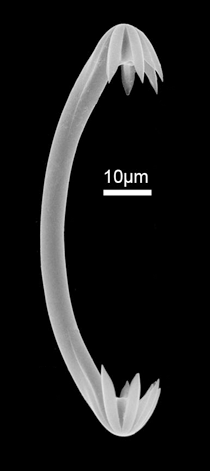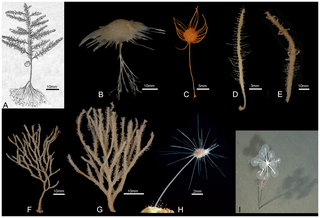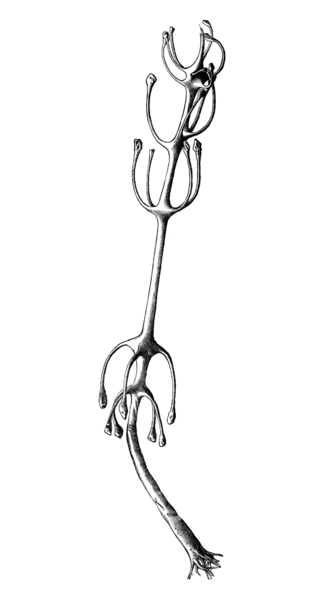
Sponges or sea sponges are members of the metazoan phylum Porifera, a basal animal clade and a sister taxon of the diploblasts. They are sessile filter feeders that are bound to the seabed, and are one of the most ancient members of macrobenthos, with many historical species being important reef-building organisms.

Demosponges (Demospongiae) are the most diverse class in the phylum Porifera. They include greater than 90% of all species of sponges with nearly 8,800 species worldwide. They are sponges with a soft body that covers a hard, often massive skeleton made of calcium carbonate, either aragonite or calcite. They are predominantly leuconoid in structure. Their "skeletons" are made of spicules consisting of fibers of the protein spongin, the mineral silica, or both. Where spicules of silica are present, they have a different shape from those in the otherwise similar glass sponges. Some species, in particular from the Antarctic, obtain the silica for spicule building from the ingestion of siliceous diatoms.

Cladorhiza is a genus of carnivorous sponges, comprising around 40 species found in oceans around the world. Cladorhiza is the type genus of the family Cladorhizidae.

Chondrocladia is a genus of carnivorous demosponges of the family Cladorhizidae. Neocladia was long considered a junior synonym, but recently become accepted as a distinct genus.

Homosclerophorida is an order of marine sponges. It is the only order in the monotypic class Homoscleromorpha. The order is composed of two families: Plakinidae and Oscarellidae.

Chondrocladia turbiformis is a recently discovered species of carnivorous sponge.
Chondrocladia lyra, also known as the lyre sponge or harp sponge, is a species of carnivorous deep-sea sponge first discovered off the Californian coast living at depths of 10,800–11,500 feet (3,300–3,500 m) by Welton L. Lee, Henry M Reiswig, William C. Austin, and Lonny Lundsten from the Monterey Bay Aquarium Research Institute (MBARI).

Cliona viridis, commonly called the green boring sponge, is a species of demosponge in the family Clionaidae. Its form varies according to the nature of the surface on which it grows. In limestone and other calcareous substrates it excavates channels and chambers while on other types of rock it encrusts the surface or forms massive structures. It is native to the eastern Atlantic, the Mediterranean Sea and the Indo-Pacific Ocean.

Cladorhizidae is a family of carnivorous demosponges found in deep-sea environments worldwide. These sponges are known for their unique feeding structures and predatory behavior, as they capture and consume small animals such as crustaceans.
Cladorhiza caillieti is a carnivorous sponge of the family Cladorhizidae described in 2014 from specimens collected from the Juan de Fuca Ridge off the coast of Vancouver Island. It feeds on small crustaceans such as amphipods and copepods. C. caillieti is an elongate, bottlebrush-shaped sponge with filaments projecting from a main stem, and ranges from 7 to 9 cm in height. The specific epithet honors Dr. Gregor M. Cailliet of the Moss Landing Marine Laboratories.

Chondrocladia concrescens is a species of deep-sea carnivorous sponge in the family Cladorhizidae. It is commonly known as the "ping pong tree sponge" due to its distinctive tree-like shape with multiple branches. The species is found in the eastern Pacific Ocean and can grow up to one meter in height.

Spiculosiphon oceana is a giant species of foraminifera. Its appearance and lifestyle mimics that of a sponge. It was discovered in 2013 in underwater caves 30 miles off the coast of Spain.

Rossellidae is a family of glass sponges belonging to the order Lyssacinosa. The family has a cosmopolitan distribution and is found at a large range of depths.
Nicole Boury-Esnault is a retired French researcher of sponges, formerly at Centre d'Océanologie de Marseille, Aix-Marseille University.

Discodermia is a genus of deep-water sea sponge.
Jean Vacelet is a French marine biologist who specialises in the underwater fauna of the Mediterranean. After earning his licence at the Faculté des Sciences de Marseille and learning to dive in 1954, he specialised in the study of sponges at the Marine station of Endoume, and there he has stayed faithful to both sponges and place for more than half a century. His research has included all aspects of sponges: taxonomy, habitat, biology, anatomy, their bacterial associations, and their place in the evolution of multi-celled animals. He has studied them not only in the Mediterranean but in the Indian Ocean and the Pacific. Exploration of underwater grottoes, together with Jacques Laborel and Jo Hamelin, revealed the existence of sponges dating from very ancient geological periods and the unexpected existence of carnivorous sponges, and surprisingly, the grottoes in some ways mimicked life at much greater depths.

Latrunculia is a genus of demosponges. It is well known for the diverse array of chemical compounds found in its species, including the latrunculins, which are named after this genus. Many of these are medically important, including anti-cancer compounds such as discorhabdins.
Michelle Kelly, also known as Michelle Kelly-Borges, is a New Zealand scientist who specialises in sponges, their chemistry, their evolution, taxonomy, systematics, and ecology.

Abyssocladia is a genus of the family Cladorhizidae, a family of carnivorous sponges. It is made up of at least 39 species found in oceans all over the world.
Oopsacas minuta is a glass sponge that is a member of the Hexactinellida. Oopsacas minuta is found in submarine caves in the Mediterranean. It is reproductive year-round. This species is a part of a class that are usually bathyal and abyssal. Meaning they grow at a depth over 200 meters. At this depth the temperature is low and constant, so silica metabolism is optimized. However, this species has been observed in shallow water. O. minuta have only been observed by exploring caves that trap cold water. The shape of the sponge is elongated, cylindrical and a little flared. It is between a few millimeters and 3.5 centimeters. O. minuta are white are held up with a siliceous skeleton. The spicules of the skeleton intersect in an intricate network. These spindles partially block the top of the sponge. There are no obvious oscules. The sponge is anchored or suspended from the cave by silica fibers. This class of sponge is different from the three other classes of Porifera. It differs in tissue organization, ecology, development and physiology. O. minuta belongs to the order Lyssacinosida. Lyssacinosida are characterized by the parenchymal spicules mostly being unconnected; this is unlike other sponges in the subclass where the spicules form a connected skeleton. The genome of O. minuta are one of the smallest of all the animal genomes that have been sequenced so far. Its genome contains 24 noncoding genes and 14 protein-encoding genes. The spindles of O. minuta have three axes and six points. This species does not have pinacocytes, which are the cells that form the outer layer in other sponges. Instead of true choanocytes it has frill structures that bud from the syncytium.













